|
Latin
America:
Jaguars Awaken
Map
|
Human Development Index:
Latin America and the Caribbean
|
|
|
Human Development Index
|
Life expectancy at birth
|
Expected years of
schooling
|
Mean years of schooling
|
Gross national income per
capita
|
HDI rank
|
|
HDI rank
|
|
Value
|
(years)
|
(years)
|
(years)
|
(2017 PPP $)
|
|
|
|
2021
|
2021
|
2021
|
2021
|
2021
|
2020
|
|
42
|
Chile
|
0.855
|
78.9
|
16.7
|
10.9
|
24,563
|
43
|
|
47
|
Argentina
|
0.842
|
75.4
|
17.9
|
11.1
|
20,925
|
47
|
|
55
|
Bahamas
|
0.812
|
71.6
|
12.9
|
12.6
|
30,486
|
58
|
|
58
|
Costa
Rica
|
0.809
|
77.0
|
16.5
|
8.8
|
19,974
|
57
|
|
58
|
Uruguay
|
0.809
|
75.4
|
16.8
|
9.0
|
21,269
|
55
|
|
61
|
Panama
|
0.805
|
76.2
|
13.1
|
10.5
|
26,957
|
67
|
|
68
|
Grenada
|
0.795
|
74.9
|
18.7
|
9.0
|
13,484
|
70
|
|
70
|
Barbados
|
0.790
|
77.6
|
15.7
|
9.9
|
12,306
|
71
|
|
71
|
Antigua
and Barbuda
|
0.788
|
78.5
|
14.2
|
9.3
|
16,792
|
71
|
|
75
|
Saint
Kitts and Nevis
|
0.777
|
71.7
|
15.4
|
8.7
|
23,358
|
76
|
|
80
|
Dominican
Republic
|
0.767
|
72.6
|
14.5
|
9.3
|
17,990
|
82
|
|
83
|
Cuba
|
0.764
|
73.7
|
14.4
|
12.5
|
7,879
|
73
|
|
84
|
Peru
|
0.762
|
72.4
|
15.4
|
9.9
|
12,246
|
85
|
|
86
|
Mexico
|
0.758
|
70.2
|
14.9
|
9.2
|
17,896
|
88
|
|
87
|
Brazil
|
0.754
|
72.8
|
15.6
|
8.1
|
14,370
|
86
|
|
88
|
Colombia
|
0.752
|
72.8
|
14.4
|
8.9
|
14,384
|
88
|
|
89
|
St
Vincent & Grenadines
|
0.751
|
69.6
|
14.7
|
10.8
|
11,961
|
82
|
|
95
|
Ecuador
|
0.740
|
73.7
|
14.6
|
8.8
|
10,312
|
99
|
|
102
|
Dominica
|
0.720
|
72.8
|
13.3
|
8.1
|
11,488
|
106
|
|
105
|
Paraguay
|
0.717
|
70.3
|
13.0
|
8.9
|
12,349
|
100
|
|
106
|
Saint
Lucia
|
0.715
|
71.1
|
12.9
|
8.5
|
12,048
|
104
|
|
108
|
Guyana
|
0.714
|
65.7
|
12.5
|
8.6
|
22,465
|
107
|
|
110
|
Jamaica
|
0.709
|
70.5
|
13.4
|
9.2
|
8,834
|
110
|
|
118
|
Bolivia
|
0.692
|
63.6
|
14.9
|
9.8
|
8,111
|
119
|
|
120
|
Venezuela
|
0.691
|
70.6
|
12.8
|
11.1
|
4,811
|
118
|
|
123
|
Belize
|
0.683
|
70.5
|
13.0
|
8.8
|
6,309
|
120
|
|
125
|
El
Salvador
|
0.675
|
70.7
|
12.7
|
7.2
|
8,296
|
124
|
|
126
|
Nicaragua
|
0.667
|
73.8
|
12.6
|
7.1
|
5,625
|
129
|
|
135
|
Guatemala
|
0.627
|
69.2
|
10.6
|
5.7
|
8,723
|
133
|
|
137
|
Honduras
|
0.621
|
70.1
|
10.1
|
7.1
|
5,298
|
138
|
|
163
|
Haiti
|
0.535
|
63.2
|
9.7
|
5.6
|
2,848
|
162
|
|
|
|
|
|
|
|
|
|
|
|
|
|
|
|
|
|
Developing
countries
|
0.685
|
69.9
|
12.3
|
7.5
|
10,704
|
—
|
|
|
|
|
|
|
|
|
|
Regions
|
|
|
|
|
|
|
|
Arab
States
|
0.708
|
70.9
|
12.4
|
8.0
|
13,501
|
—
|
|
East
Asia and the Pacific
|
0.749
|
75.6
|
13.8
|
7.8
|
15,580
|
—
|
|
Europe
and Central Asia
|
0.796
|
72.9
|
15.4
|
10.6
|
19,352
|
—
|
|
Latin
America and the Caribbean
|
0.754
|
72.1
|
14.8
|
9.0
|
14,521
|
—
|
|
South
Asia
|
0.632
|
67.9
|
11.6
|
6.7
|
6,481
|
—
|
|
Sub-Saharan
Africa
|
0.547
|
60.1
|
10.3
|
6.0
|
3,699
|
—
|
NOTE: Venezuela fell from rank 78 in the 2018 report to 118
in 2020, and to 120 in the 2021 ranking.
If you can stand it, see this
terrible PBS NewsHour report on the crumbling Venezuelan
health care system.
For background on the crazy version of populism that eventually
led to the Venezuelan meltdown, see
this 2008 Frontline documentary about Hugo Chavez, the
former leader.
I.
Environment
A. Indigenous Cultures
1.
Mayas
- settled
about 5,000 years ago in Middle America, in the areas of
modern southern Mexico, Guatemala, and Belize, and reached
the height of their "classical period" between 250 and
900CE. “Greeks of Latin America.” Built magnificent pyramids
and palaces, and astronomers developed an accurate calendar.
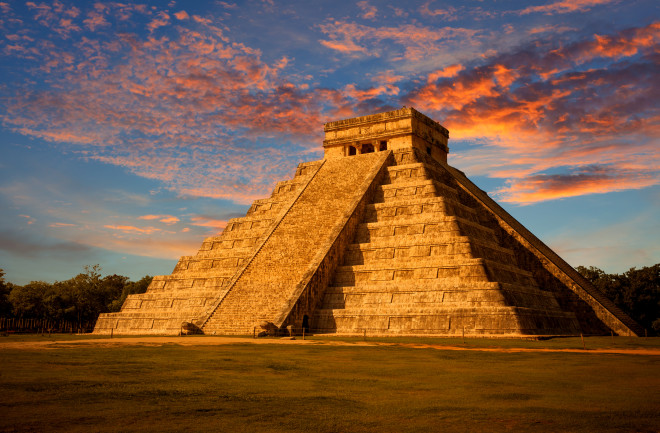
2.
Aztecs
- Powerful
society in Mexico early in 14th century, used
advanced agricultural techniques. Later, used ruthless force
to extract tribute and subjects of human sacrifice.
3.
Incas - Largest, most organized American empire late in
the twelfth century. About 20 million people in the Andean
region from southern Colombia to central Chile. Early versions
of central planning and communal agricultural labor.
Summary -
Experience with social, economic, and political development,
authoritarian organization, and something similar to colonial
exploitation long before the Europeans arrived.
II. History
A.
European Pre-History
711CE -
Muslim "Moors" from northwest Africa conquered the Iberian
peninsula (Spain and Portugal) and later also conquered
Sicily, and introduced their religious practices along with
beautiful artistic and architectural traditions.

718-1492CE
- The Reconquista (700-year struggle to regain
territory from the Moors) began with the Battle of Covadonga,
the first Christian victory over Arab-Berber forces. As
territory was conquered, Muslims and Jews were forced to
either leave Iberia or convert to Catholicism to stay, and
some blended Christianity with their previous faiths.
1478-1834CE
- The Spanish Inquisition imposed Catholic orthodoxy on those
who converted from Islam or Judaism to Christianity during the
Reconquista and eventually spread to North and South
America. Around 150,000 people were prosecuted,
including about 4,000 who were executed.
A. Colonial Period
1.
Authoritarian practices and institutions that developed in
Spain during the Reconquista and Inquisition were
transplanted to Latin America.
2.
Extractive motives. Distorted transportation systems.
3.
Top administrators were born in Europe; lower posts held by criollos (people of pure Spanish
descent, born in America) and mestizos
(people with mixed
Spanish and indigenous heritage), leading to the
rise of a middle class.
4.
Growing population needed more food-- dualistic system of latifundios and minifundios.
B. Independence
1.
Forces for independence. America example ports to British
ships, weakening the system of colonial control. All
free by 1824;
2.
Few internal structural reforms
C.
Import Substitution, State Control, and Revolution
1.
Export-led growth continued until the 1930s, then ISI,
supported by ECLA. Real incomes nearly doubled between 1950
and 1973.
2.
Deficiency of ISI strategy-- authoritarianism. Perón, Castro,
Allende examples.
D. Export Promotion and Market Reform
1.
Brazilian military leaders adopted export-oriented development
strategy and an open door to foreign investment. For several
years, this strategy seemed successful.
2.
Pinochet in Chile, beginning in 1973.
3.
Debt crisis, late-1980s and early-1990s
II.
Agriculture
A. Share
of total employment fell from 20% (for the full region) in
1992 to 14% in 2013. However, that's still much higher than 2%
in North America. Agriculture accounts for about half of total
exports from Argentina (the world's largest exporter of
soybeans) and about 60-70% of exports for Nicaragua and
Uruguay.
B.
Before
1910 in Mexico, mainly small holdings with no titling of land.
Afterward, during the presidency of Porfirio Díaz,
privatization that created plantations and haciendas. Many
small holders lost their ancestral land to large estates.
C. Revolution and Land Reform
In Mexico, that
led to the Revolution that forced Diaz to resign in 1911.
However, disputes over land ownership have continued
throughout the region. Latin America still seems to have
the greatest inequalities of agricultural land holdings in
the world, and
recent
econometric evidence suggests that this reduces
productivity.
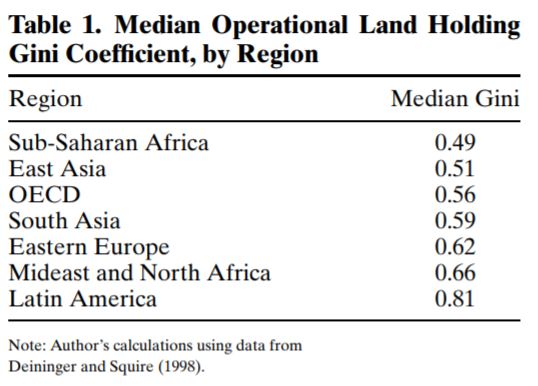
III.
Industrial Organization
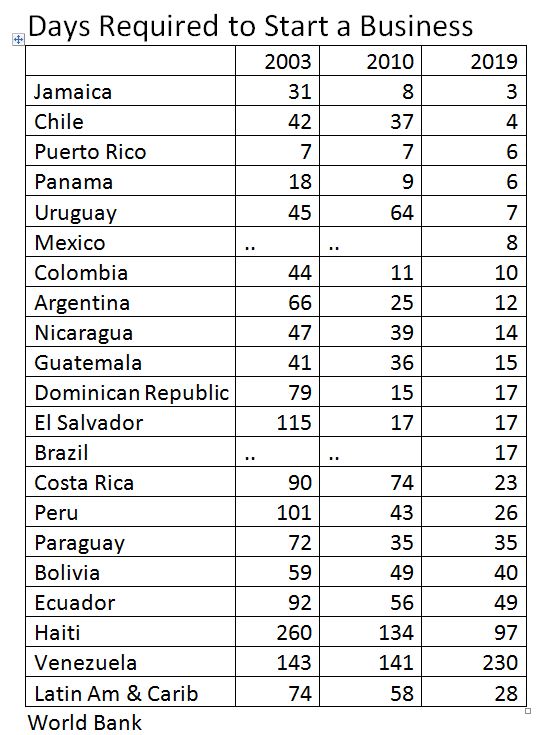
A. Microenterprises are the norm,
but larger companies account for most of employment and sales.
B. Informal Economy - according
to IADB, it accounts for 54% of employment and these
workers have no access to hospitals and other social services.
C. Maquiladoras
- after 1966, using treaty between Mexico and the
United States that created special duty-free zones. Symbolize
flight of manufacturing jobs to factories in Latin America.
Lost special tariff status in the year 2001 when all of
Mexico became a free-trade zone, however that has not stunted
their importance. NAFTA triggered a rapid expansion of
manufacturing in Mexico. In the year before NAFTA, there were
2,114 maquiladoras with 500,000 workers. Within six years,
more than 1,400 new maquiladora plants opened and maquila
employment doubled to 1.3 million. After China entered the WTO
in 2000, there was a decline in growth of maquiladora
factories, but as Chinese wages began to outpace Mexican
manufacturing wages, the maquiladora industry, now organized
by IMMEX (Manufacturera Maquiladora y de Servicios de
Exportacion), began to grow again. By 2014, maquiladoras
employed 80 percent of Mexico’s manufacturing workers.
When Trump started a "trade war" with China in 2016, that gave
another boost to Mexico as an alternate source of low-wage
goods, and then the supply-chain disruptions of COVID and
continuing deterioration of relations with China reinforced
it. Now, foreign investors such as Foxconn (Taiwan) and Man
Wah Furniture Manufacturing (mainland China) are opening huge
facilities in Mexico to reduce transport costs and to
strengthen access to the U.S. market. In 2021, Chinese
companies were responsible for 30 percent of foreign
investment in Nuevo León, second only to the United States at
47 percent. The U.S.-Mexico port of entry in Laredo, Texas,
now competes, month-to-month, with Los Angeles as the most
important shipping port to the U.S.
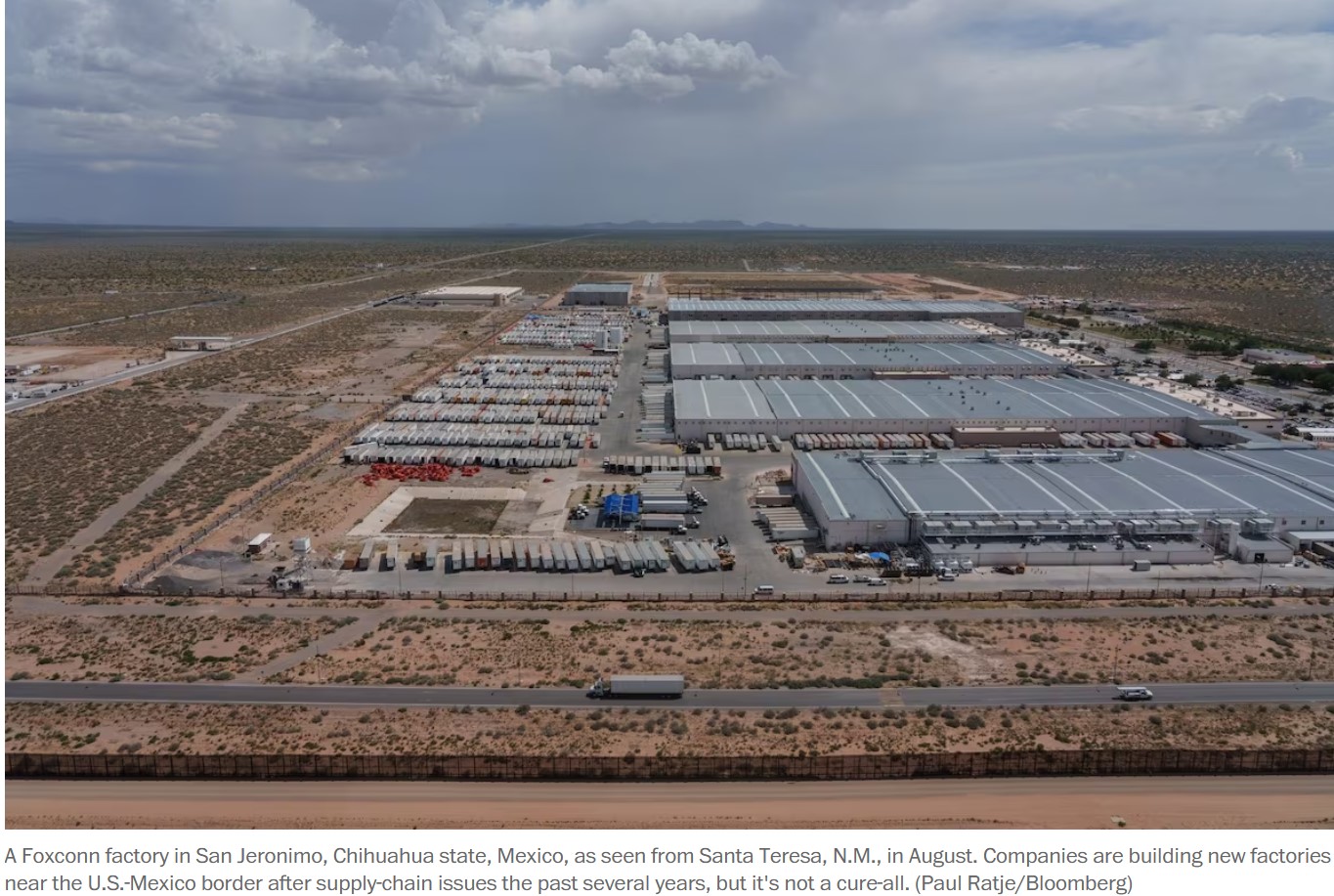
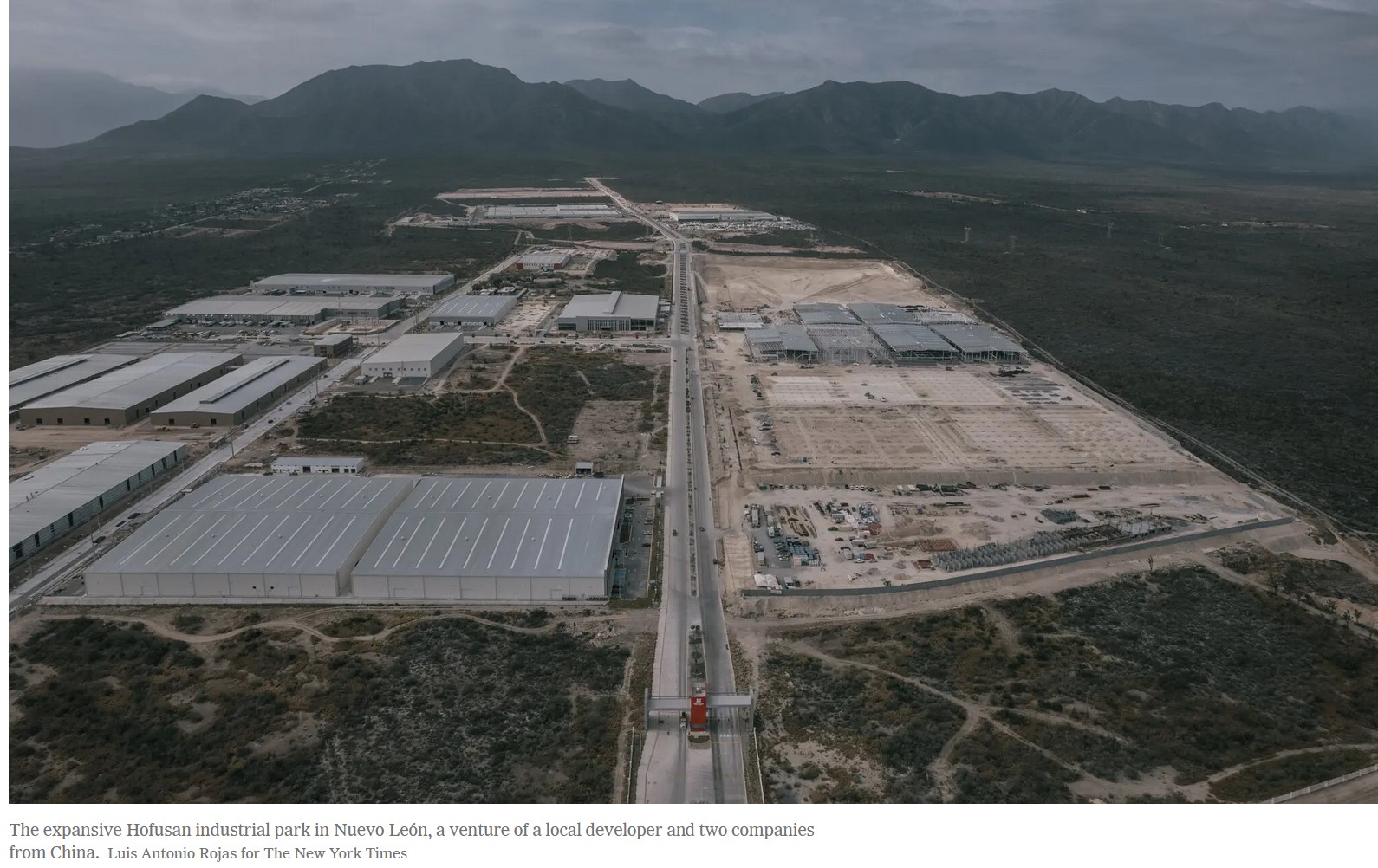
D. State Ownership and Privatization
1.
Long history of state participation, going to Incas and Aztecs.
2.
During 1930s, dissatisfaction with foreign owners led to
expropriation and nationalization of energy, telephone
systems, and other public utilities. For example, a dispute
over wages and benefits in 1938 led to seizure of the Mexican
oil industry from 17 companies, and to the creation of a
state-owned petroleum monopoly, Petróleos Mexicanos (PEMEX),
still the largest company in Mexico.
3.
Also in 1930s, ISI led to the establishment of state-owned
manufacturing companies. This process continued after World
War II, and accelerated during the 1960s.
4.
During the 1990s, Latin America led the developing world in
privatization, accounting for about 56% of all privatization
revenues, and reducing the state-produced share of GDP to
nearly the level of high-income "industrial" countries.
IV. The
Labor Market
A.
Difficult to develop stable systems of collective bargaining.
19th century legal codes in many countries
prohibited workers from signing binding contracts with their
employers.
B.
Generally, labor unions were illegal until early twentieth
century. Earliest unions, encouraged by the Catholic Church,
allowed workers to pool resources in a social insurance
system; usually no attempt to bargain with employers.
Eventually, when unions attempted to organize strikes,
governments often supported employers with military force.
C.
During Great Depression, more labor codes to protect rights of
workers. With growth of state-owned enterprises, governments
unable to serve as impartial referees.
D.
Now, privatizations, efforts for more cooperative
relationships, consultation - Economic Solidarity Pacts in
Mexico; spread to other countries.
E.
Labor market inflexibilities - Laws prohibiting temporary
employment and requiring large severance payments for "unjust"
dismissals; severance payments are larger than similar
payments in Europe; relatively high social security payroll
taxes. Chile shifted to a system based on personal saving,
rather than on taxation.
V.
Inflation and the Financial Sector
A.
Inflation
1.
Consumer Price Inflation Rates
2.
Traditional explanations: Monetarism (too much money creation)
vs Structuralism
(too little land reform and other structural change)
But these are unsatisfying.
3.
Alternatives:
(1) Political instability encourages governments to look for
quick fixes for unemployment. The Friedman/Phelps acceleration
hypothesis suggests that you can reduce unemployment below the
natural rate temporarily by accelerating inflation, but the
cost of keeping unemployment below the natural rate in the
longer run is continual acceleration of inflation.
(2) ISI reduces financial discipline,
because it protects the economy from imports, and doesn't
emphasize export competitiveness.
(3) Indexation
- Friedman thought that tying wage and other contracts to
price indexes would remove the Central Bank's incentive to
inflate. Instead, it may have reduced political resistance to
inflation.
B.
Financial Repression and Liberalization
If
nominal interest rates are controlled while inflation
accelerates, real interest rates become negative, so credit
markets and market-oriented financial institutions cannot play
their normal role to stimulate savings or efficiently allocate
financial resources. Governments increase intervention: Credit
rationing, foreign exchange regulation.
Debt
crisis made all these problems worse, forced reforms, restored
capital inflows (for better or worse).
VI. The
Church, the State, and the Poor
A.
Poverty during the 1980s -- debt crisis and regional
distribution of income.
B.
The Role of the Church -
1.
Traditional charitable role of Roman Catholic church,
2.
Liberation theology, arose in connection with reforms in the
Church with the 2nd Vatican Councilclarified (1962-1965),
and with the publication of Gustavo Gutiérrez's book, A
Theology of Liberation in 1971, popularizing the phrase,
"preferential option for the poor."
3.
Liberation theology was opposed by Pope John Paul II (born in
Poland, was Pope from 1978-2005), but a 1995 Bishop's meeting
in Mexico City declared that the ruling neoliberal orthodoxy
"unnatural and inhuman," and eventually "will fall by itself,
perhaps more rapidly than communism." Now, Pope Francis, a
product of his native Argentina, is far more supportive of the
tenets of liberation theology. As he wrote in 2020 in Fratelli
Tutti:
"Development must not aim at the amassing of wealth by a few,
but must ensure “human rights – personal and social, economic
and political, including the rights of nations and of
peoples”.[99] The right of some to free enterprise or market
freedom cannot supersede the rights of peoples and the dignity
of the poor, or, for that matter, respect for the natural
environment, for “if we make something our own, it is only to
administer it for the good of all”
From the Latinobarometro 2018 and
2020 reports:
http://www.latinobarometro.org/
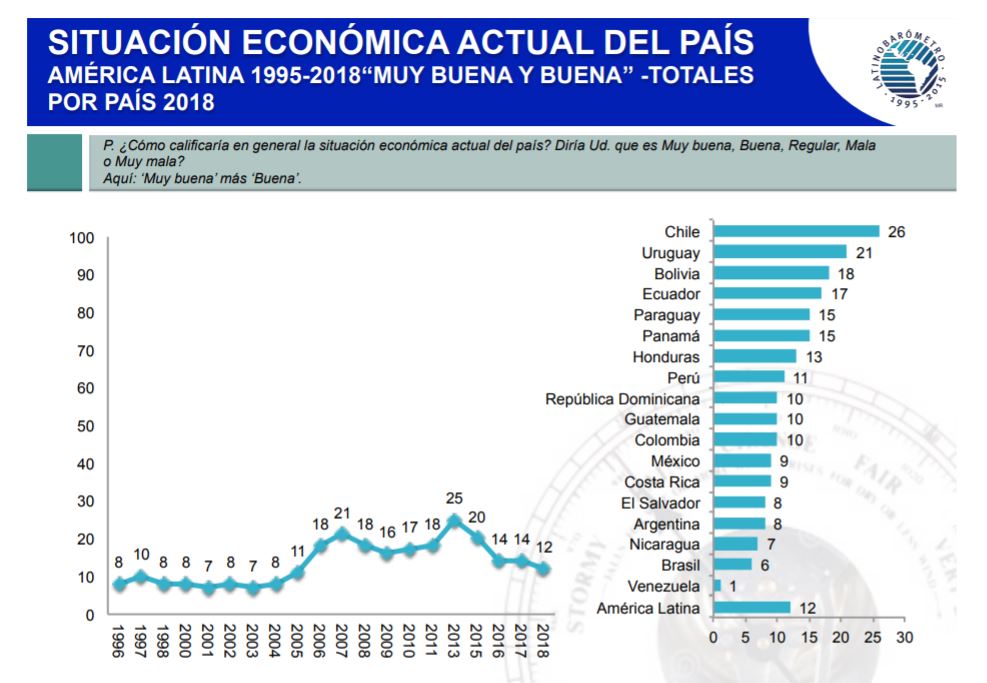
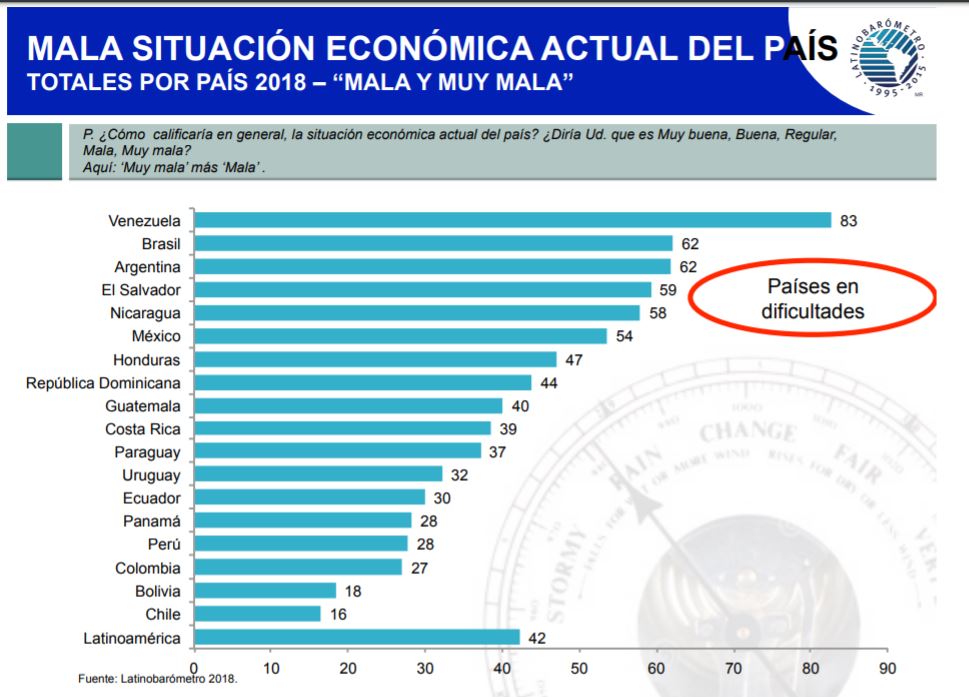
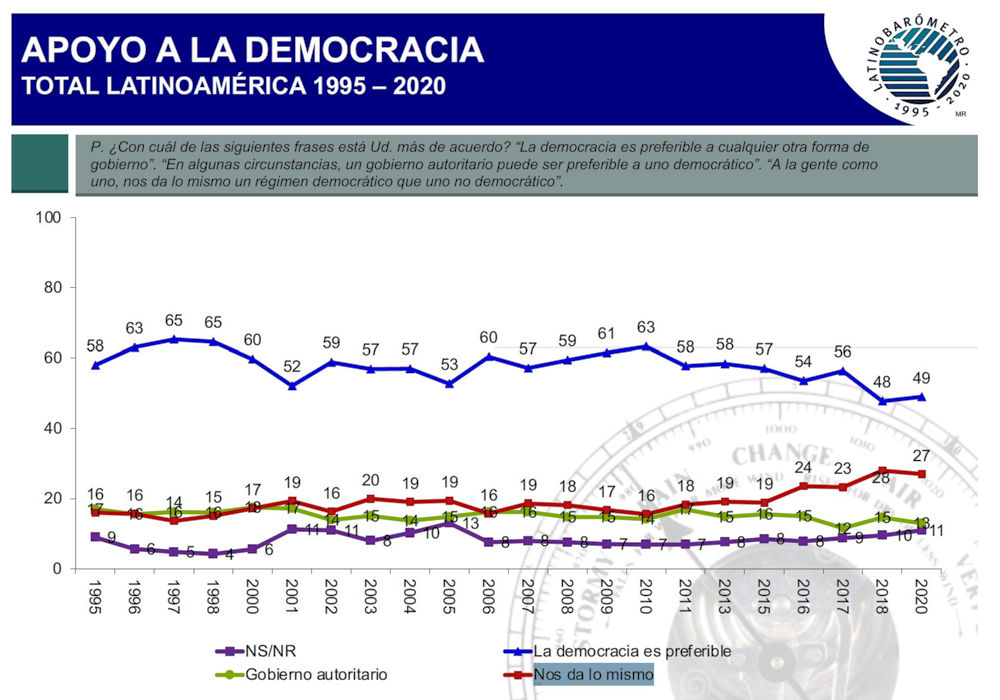
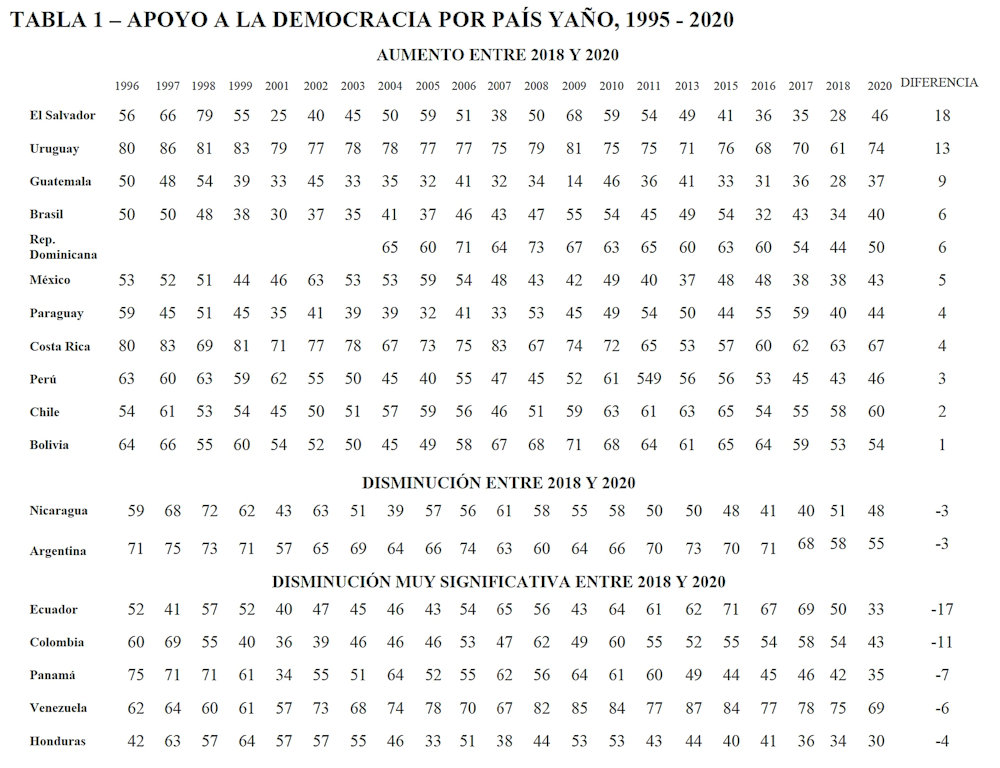
|